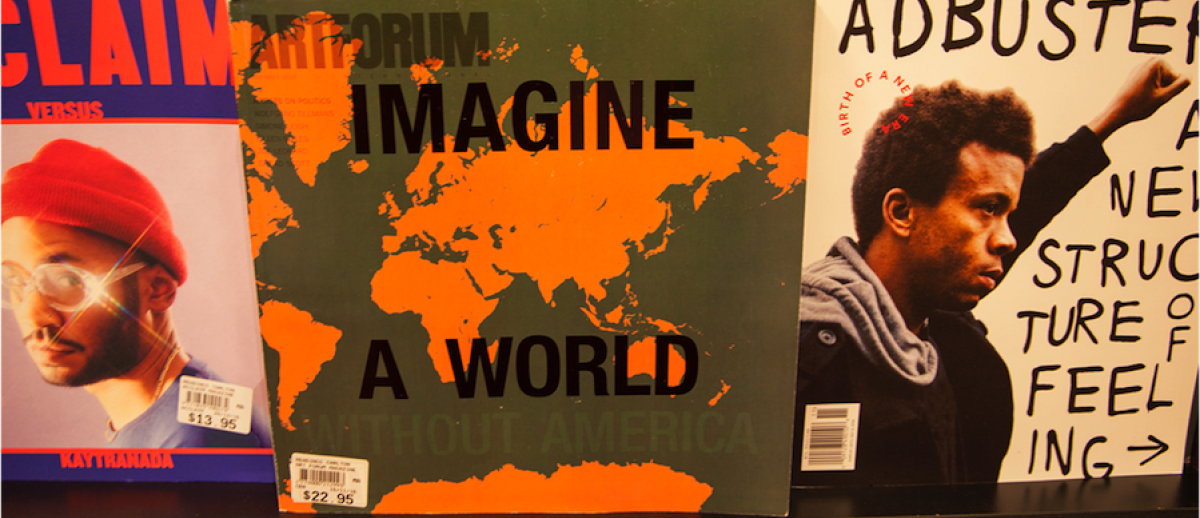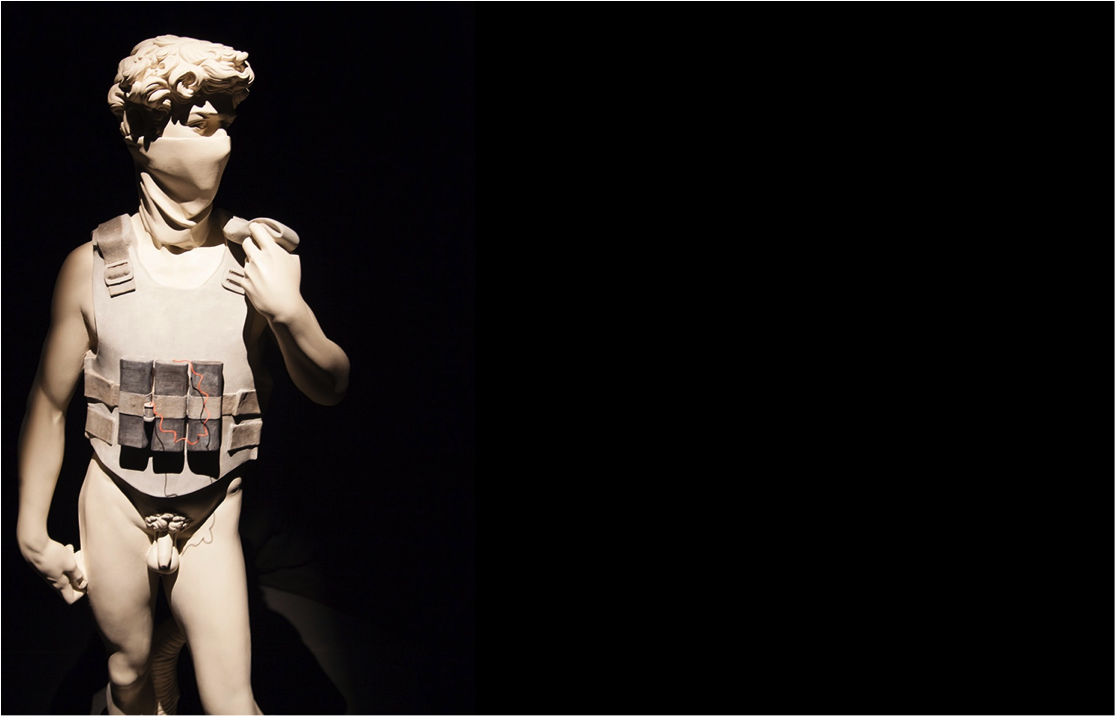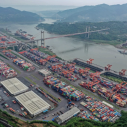Visible Discourses and Invisible Ideologies? The Image as Global Political Theory
archive


“Imagine a World Without America.” Artforum Magazine Cover, November 2016, Melbourne, Australia ©Tommaso Durante/Global Visual Politics
Visible Discourses and Invisible Ideologies? The Image as Global Political Theory
Visual information in the form of images shape almost every event of our phenomenological existence, profoundly affecting the ways we understand and take action in the world around us. Moreover, the reign of the visual is ever-increasing, and it comes as no surprise that the ‘pictorial turn’ has supplanted the ‘linguistic turn’ in the study of culture (Mitchell, 1995). On Instagram alone, 40 billion photos have been shared since the application was launched in October 2010 and an average of 95 million photos are uploaded daily (Omnicore Group, 2018). Indeed, visual images, continuously produced in forms and on a scale never experienced before by human beings, have come to dominate our experience of the world. They not only represent and reflect the world in which we live but, more importantly, they contribute to constructing and continuously changing it. As a result, visual images play a strategic role in the symbolic and social construction of people’s collective imaginaries and historical consciousness. Images are able to reshape people’s mindset, sustain revolutions and set off wars and conflicts, but they also contribute to reconciliation and building peace (Durante, forthcoming 2019).
At present, images are generated, spread, and consumed mostly through the massive use of personal electronic devices such as smart-phone cameras and tablets, but also professional cameras, drones, satellites, and surveillance cameras. Images are ubiquitous and are able to convey and represent almost everything. They can be analyzed for marketing, academic research, and scientific purposes, or stored in archives to be further interpreted in security contexts. Visual images in the global era of ‘platform capitalism’ (Bratton, 2012; Srnicek, 2017) are rapidly shared and consumed mostly in the different (digital) materiality of the social (global) web. It is important to remember that the Internet is not a magical realm, but has rather a physical and material existence (Parker, 2015). Yet, in the field of International Relations (IR) and in the 'new' field of Global Studies (GS), visual images are still largely approached with prejudices not usually applied to the written text. Thus, in appreciating the symbolic power of the visual and in accepting the methodological challenges that visual images pose, this short essay combines theory and practice to address the image as global political theory. Precisely, the study explores to what extent visual images in their own right are able to produce global politics, while contributing to the emergence of a ‘global visual culture’ (Mirzoeff, 2005) under present conditions of neoliberal globalization (marketization of culture and personal relationships).
On these premises, this practice-led investigation addresses the following research questions: “Do visual images produce theory?”; “Do images have power, or are we giving power to images?”; “What is the symbolic power of an image?”; and “How do visual images respond to a global political event and how do they shape it?” In doing so, the inquiry aims to expand our knowledge about image-theory production and our understanding of the emergence of a new visual epistemic regime of the global in relation to the dynamics of global politics.
Furthermore, the study acknowledges that we need to distinguish between representation and description (Ankersmit, 1996). This means that we must redefine the traditional disciplinary approach to visual images and the ways we understand and investigate global politics by also appreciating the complexity of the politics of representation itself. However, this implies not only a better understanding of the nature of semantics or a change in perspective about it; rather, it is mostly about an understanding of the ideological difference between a statement (text) and an image (representation), since they are produced and consumed through different symbolic systems. Therefore, they need to be approached and understood differently. As Franklin R. Ankersmit observes, the event in itself does not influence how we make sense of it since it cannot determine our perspective. The politics of representation is not in contradiction with reality: it simply organizes knowledge and allows us to interpret reality in a process that should not be subjugated to the dualism of truth and falsity (1996).

London Pride event, July 7, 2018 © Tommaso Durante/Global Visual Politics
Thus, while I can share with Roland Bleiker the idea that “no representation, even the most systematic empirical inquiry, can represent its object of inquiry as is. Any form of representation is inevitably a process of interpretation and abstraction” (2017, p. 16), at the same time I totally disagree with the social theorist when he says that “images make no sense by themselves. They need to be seen and interpreted” (Bleiker, 2017, p. 16). Actually, the symbolic power of the image relies on the fact that it can be absorbed consciously or unconsciously without any dedicated (tailored) critical approach, as happens with everyday people in daily life. Recent scientific psychological studies for the first time have explained that emotions can be unconsciously evoked and manipulated. Therefore, this study suggests that humans do not need to be aware of an event that caused their mood or feelings in order to be affected by it (Ruys and Stapel, 2008). Similarly, the image of an event is always socio-historically, emotionally, and ideologically charged. Furthermore, when compared to the text, the visual image has both a ‘surplus value’ (Mitchell, 2006, pp. 76-110) due to its capacity to convey the complexity of the social world, and an element of weakness because it will never be a statement, since the image is a polysemic construct.
...we must redefine the traditional disciplinary approach to visual images and the ways we understand and investigate global politics by also appreciating the complexity of the politics of representation itself.
Image can also be a very useful research tool in the fields of IR and GS since it can exemplify the complex (abstract) dynamics of globalization, while problematizing the process of representation itself. In these latter two functions I identify an image’s political significance and symbolic power.
What follows are two brief examples. The first refers to a photograph I took at a street art exhibition in Melbourne, Australia in 2017 portraying an assemblage by world-famous street artist, Banksy. The artist used a replica of the marble sculpture of a standing male nude representing the Biblical hero David by Michelangelo, a religious symbol that subsequently came to symbolize the defense of civil liberties in the Republic of Florence. A very rough industrial copy of Michelangelo’s artwork was installed in a tent in a fully immersed dark area with an improvised explosive device on it, turning the David into a suicide bomber. The result is of global political significance, obviously very different with respect to the statue installed in Piazza della Signoria in Florence, Italy. The re-signified sculpture is open to a multitude of interpretations, and this is its super-value but, at the same time, its weakness, since it is not a clear statement against or even in favor of Christian or Islamic religious fundamentalism. However, the shock effect produced by the combination of two culturally very different and highly emotionally and ideologically charged symbols affects people consciously and unconsciously by creating a sense of discomfort through shock effect (the juxtaposition of a work of art and an explosive device that symbolizes terrorist violence). This effect occurs not only during the art exhibition, but through the diverse media replications and across cyberspace.

Michelangelo's David as suicide bomber, The Art of Banksy Exhibition, Melbourne, Australia 2017 © Tommaso Durante/Global Visual Politics
I took the second image in Washington, D.C. in February 2012. It depicts the slogan “We are the 99%” widely used by the Occupy movements started in New York (Wall Street) in 2011 which rapidly spread on global scale due to the large number of people mobilized through the Internet. The powerful visual rhetoric of this event/image brings ‘the people’ (the 99%) onto the public stage and, in doing so, it also suggests the urgency of negotiating power with the eltie 1%. In underlining the difference between “us” and “them,” the image conveys concepts related to inequality and disadvantage for the 99% of the global population with a clear reference to the power held by the remaining 1%. This image clearly affects the collective imaginaries and political ideologies of individuals, both consciously and unconsciously.

'Occupy Wall Street' Camp in Washington, DC, 2012 © Tommaso Durante/Global Visual Politics
Whether or not we acknowledge that global politics need to be critically approached through a transdisciplinary global framework and tailored methodologies (Darian-Smith and McCarthy 2017, Steger and Wahlrab, 2017) in order to better understand the socio-political and cultural implications of image production and consumption, it remains a fact that on a daily global scale images are reshaping people’s mindset by contributing to the construction of “global subjectivities” at the local scale (Durante, forthcoming 2019). However, the fact that visual images dominate the world does not mean that they are a substitute for textuality, since they function and therefore demand to be understood differently from texts. As a result, the emerging global visual culture should be approached by evaluating not merely its possible dangers, but also the associated opportunities. Think for instance of the complexity of the social world that the visual image is able to convey with respect to a statement; the exemplification of phenomena such visualizing globalization as a new form of symbolic and ideological spatialization; and the problematicization of media representation itself, just to mention a few. Further, it can be observed that, in the dawning age of artificial intelligence and the accelerating global spread of visual technologies (and digital humanities), we should anticipate the need to acquire a new literacy to face the dramatic change in the ways we communicate, share, and consume images and ideas. This calls for an urgent redefinition of the use of the images in academic research and more specifically in the fields of IR and GS political theory. In this respect, I argue for the necessity of introducing on a global scale the study of critical visual pedagogy at primary and secondary levels, and the study of visual rhetoric and global urban iconology at the university level. This would help to broaden understanding of both the political role of media representations, and how visual images affect people’s imaginaries and ideologies under present conditions of neoliberal globalization.
Ankersmit, Franklin Rudolf. 1996, pp. 39–40). Aesthetic Politics: Political Philosophy Beyond Fact and Value. Stanford: Stanford University Press.
Bleiker, Roland. 2009. “The Aesthetic Turn in International Political Theory. “Aesthetics and World Politics. London: Palgrave Macmillan.
Bleiker, Roland. 2017. Visual Global Politics. 2017. Routledge.
Bratton, Benjamin H. 2015. The Stack: On Software and Sovereignty. Cambridge, MA: Massachusetts Institute of Technology.
Darian-Smith, E. and McCarthy. P. (2017). “A Global Theoretical Framework.” In E. Darian-Smith & P. McCarthy, The Global Turn: Theories, Research designs, and Methods for Global Studies. (pp. 55-75). Oakland, CA: University of California Press.
Durante, Tommaso. Forthcoming 2019a. "Approaching Peace Visually: Global Imaginaries and Narratives of Everyday Peacebuilding." In The Palgrave Handbook of Global Approaches to Peace edited by Aigul Kulnazarova and Vesselin Popovski. New York: Palgrave Macmillan.
Durante, Tommaso. Forthcoming 2019b. "The Symbolic Power of the Global: Visualizing and Interpreting Ideological Change in Melbourne, Australia." In Revisiting the Global Imaginary: Theories, ideologies, subjectivities. Essays in Honour of Manfred Steger edited by Hudson, Chris and Erin K. Wilson. New York: Palgrave Macmillan.
Mirzoeff, Nicholas. 2005. Watching Babylon: The War in Iraq and Global Visual Culture. New York: Routledge.
Mitchell, W.J.T. 1995. Picture Theory: Essays on Verbal and Visual Representation. Chicago: The University of Chicago Press.
Mitchell, W. J. T. 2006. The Surplus of Value of Images.” What Do Pictures Want? The Lives and Loves of Images, pp. 76-110. Chicago: The University of Chicago Press.
Parker, Simon. 2015. Urban Theory and the Urban Experience: Encountering the City. New York: Routledge.
Kirsten I. Ruys, Diederik A. Stapel. The Secret Life of Emotions. Psychological Science, 2008; 19 (4): 385 DOI: 10.1111/j.1467-9280.2008.02097.x
Srnicek, Nick. 2016. Technology after Capitalism. Oxford: Polity Press.
Steger, Manfred B. and Wahlrab, Amentahru, 2017. What Is Global Studies? Theory and Practice. New York and London: Routledge.



